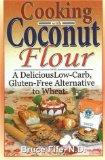
If you have celiac disease or are gluten intolerant, coconut flour can be used in cooking and baking as an alternative to gluten-containing flours. As with any flour substitute, there are advantages and disadvantages to using different products.
Taste and Texture
Coconut flour differs from wheat flour in both its texture and taste. The flour is produced from the ground meat from coconuts. It is, therefore, not a grain like other gluten-free flours such as sorghum or amaranth flours. The flour has a very fine, silky texture, similar to talcum powder.
The cream-colored flour will not significantly sweeten any recipes to which you add it. Rather, it will impart a slight nutty flavor which may influence how it can be used. You may find, however, that it may enhance the sweet flavors in your recipes. The dense texture of the ground coconut meat creates a product which will readily absorb any liquids in your recipes.
Nutritional Value
There are several health advantages to using coconut flour which may make you consider using it even if you do not typically eat gluten-free foods.

- From a nutritional standpoint, coconut flour is low in fat and high in protein. A 100 gram sample contains 19 grams of protein. An adult woman needs approximately 46 grams of protein daily, according to WebMD.com. The protein content of the flour provides over 40 percent of your daily recommended allowance, making it a significant source of dietary protein.
- The flour is also an excellent source of dietary fiber. According to the Institute of Medicine, you should consume at least 25 grams of fiber a day. Coconut flour provides a whopping 39 grams per 100 gram sample, allowing you to easily acquire adequate fiber in your diet.
- While it is relatively low in fat, most of its fat content is comprised of natural saturated fat. However, it contains neither trans fats nor cholesterol.
- Coconut flour contains very little sodium.
- Its vitamin and mineral content are not significant, though it does contain small amounts of calcium and vitamins B1 and C.
- It is a good source of iron with 100 grams providing over 50 percent of the daily recommended allowance of iron for adult women under 50 years of age.
Using Coconut Flour
You can purchase the flour online or at health food stores. Like other flour substitutes, this gluten-free flour is relatively expensive. Given its unique characteristics, you are apt to find many uses for it. Its shelf life is approximately one year. It will keep best if you store it either in your refrigerator or freezer.You may need to make modifications to some of your recipes. Because of this flour's low moisture content, you may find that using it dries out your baked goods. You should adjust your recipes by adding water or oil to make up for any moisture loss during baking.
Many companies such as Tropical Traditions and Bob's Red Mill sell organic flour, giving the added insurance of a quality coconut product. The company, Peter Paul, sells a certified kosher and organic product. You can use the flour in any of your recipes. It performs well on its own or in blends with other gluten-free flours. You may find it hard to believe that there is no gluten in it.
Coconut meal dissolves readily in water, making it a good thickening agent for your favorite sauce or stew recipe. The possibilities are endless. As with other flour alternatives, you should experiment with it and see what works for best for you.
Gluten-Free Alternative
Living a gluten-free lifestyle can be difficult, especially if you are unable to find safe alternatives for gluten-containing foods. Coconut flour offers you an alternative to wheat flour which will not only give you a good substitute, but it's inherent nutritional value makes it a healthy way to enhance your diet.







